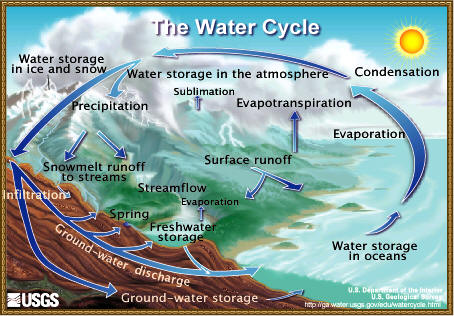|
 Water-Cycle Water-Cycle
Diagrams and Summaries
Our water-cycle diagram (about 150 kilobytes) is available in many languages. Text summaries are also available for some languages (with more on the way!).
 English English
 Afrikaans Afrikaans
 Albanian Albanian
 Amharic Amharic
 Arabic: Arabic:
 Diagram |
Summary Diagram |
Summary
 Bahasa Bahasa
 Bengali Bengali
 Bulgarian Bulgarian
 Burmese Burmese
 Chinese: Chinese:
 Diagram | Summary Diagram | Summary
 Water-Science Center Water-Science Center
 Croatian Croatian
 Czech: Czech:
 Diagram | Summary Diagram | Summary
 Danish: Danish:
 Diagram | Summary Diagram | Summary
 Dutch Dutch
 Estonian: Estonian:
 Diagram | Summary Diagram | Summary
 Farsi: Farsi:
 Diagram | Summary Diagram | Summary
 Finnish Finnish
 French: French:
 Diagram | Summary Diagram | Summary
 Georgian Georgian
 German German
 Greek: Greek:
 Diagram |
Summary Diagram |
Summary
 Hebrew Hebrew
 Hiligaynon Hiligaynon
 Hindi Hindi
 Hungarian Hungarian
 Icelandic Icelandic
 Italian: Italian:
 Diagram | Summary Diagram | Summary
 Japanese: Japanese:
 Diagram | Summary Diagram | Summary
 Kannada Kannada
 Khmer Khmer
 Korean Korean
 Kyrgyz Kyrgyz
 Lao Lao
 Latvian Latvian
 Lithuanian: Lithuanian:
 Diagram | Summary Diagram | Summary
 Macedonian: Macedonian:
 Diagram | Summary Diagram | Summary
 Malay: Malay:
 Diagram | Summary Diagram | Summary
 Malayalam Malayalam
 Mongolian Mongolian
 Nepali Nepali
 Northern Sotho Northern Sotho
 Norwegian: Norwegian:
 Diagram | Summary Diagram | Summary
 Polish: Polish:
 Diagram | Summary Diagram | Summary
 Portuguese: Portuguese:
 Diagram | Summary Diagram | Summary
 Punjabi Punjabi
 Pushto Pushto
 Romanian: Romanian:
 Diagram | Summary Diagram | Summary
 Russian: Russian:
 Diagram | Summary Diagram | Summary
 Serbian: Serbian:
 Diagram | Summary Diagram | Summary
 Sindhi: Sindhi:
 Diagram | Summary Diagram | Summary
 Slovakian Slovakian
 Slovene Slovene
 Spanish: Spanish:
 Diagram | Summary Diagram | Summary
 Swahili Swahili
 Swedish: Swedish:
 Diagram | Summary Diagram | Summary
 Tajik: Tajik:
 Diagram | Summary Diagram | Summary
 Tamil Tamil
 Telugu Telugu
 Thai Thai
 Tsonga Tsonga
 Turkish: Turkish:
 Diagram | Summary Diagram | Summary
 Ukrainian Ukrainian
 Urdu Urdu
 Uzbek Uzbek
 Vietnamese: Vietnamese:
 Diagram | Summary Diagram | Summary
 Wolof Wolof
 Zulu Zulu
|
Earth's water is always in movement, and the water cycle, also known as the hydrologic cycle, describes the continuous movement of water on, above, and below the surface of the Earth. Since the water cycle is truly a "cycle," there is no beginning or end. Water can change states among liquid, vapor, and ice at various places in the water cycle, with these processes happening in the blink of an eye and over millions of years.
Although the balance of water on Earth remains fairly constant over time, individual water molecules can come and go in a hurry. The water in the apple you ate yesterday may have fallen as rain half-way around the world last year or could have been used 100 million years ago by Mama Dinosaur to give her baby a bath.
To explore the water cycle, choose a topic from the diagram or text links below.
 Where do YOU think the water cycle begins? Give us your opinion. Where do YOU think the water cycle begins? Give us your opinion.
 A summary of the water cycle on a single Web page is also available: A summary of the water cycle on a single Web page is also available:
Complete summary • Text only • Quick summary

|